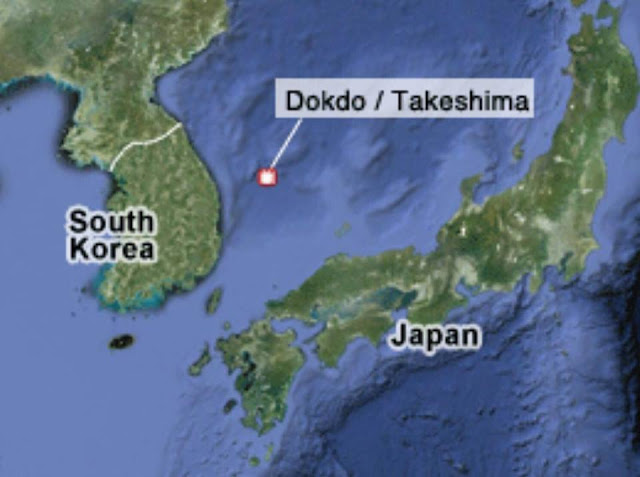Dispute over offshore territory in
East Asia are commonplace and have demonstrated difficult problems to resolve.
Since the end of World War II, Korea and Japan have contested ownership of these islets, given name Liancourt Rocks by that by neutral observes to this
day.The area
is currently occupier by South Korea, which maintains that it has always
belonged to the Republic of Korea. Concomitant with these historical claims,
economic interests also dominate any discussion of Liancourt Rocks. According
to introduction of the 1982 United Nation Convention Law of the Sea (UNCLOS),
sovereignty over offshore territory has become increasingly important and
complicated. Parties to UNCLOS are entitled to as much as 200 nautical miles of
maritime and juridical exclusivity.

This
dispute related to economic interest, territorial, sources under the islets,
and also connected with the history has shown that Korea under colonize of
Japan from 1910 to 1945. This is a hot topic that resolve many time but never
success. This dispute gave us a lot of information how to understand about the
history connected to the dispute of present, economic interest, sources under
the sea, territorial and the way to negotiate and recommend on this
dispute. Japan and Korea have been reach
so far in the history. The islets dispute that Korea named it Tokdo and Japan
named it Takeshima. The cause of conflict is the history map issue, policy
control and economic development. After the end of World War II, relations
between South Korea and japan have gone through significant changes. Despite
decades of relatively peaceful relations and growing economic inter- dependence
between Japan and the Republic of Korea (ROK), the two countries have failed to
establish strong diplomatic ties. The poor relationship is the result of the
historical animosity stemming from the Japanese occupation of Korea from 1910
until 1945. While Koreans often carry a strong sense of resentment for the past
actions of the Japanese, the latter have arguably demonstrated “a superiority
complex towards Korea inherent in the collective mindsets offormer colonizers”.
Both Korea and Japan consider the islands to be part of their own territory,
making the dispute seemingly intractable and concession next to impossible. The
Tokdo or Takeshima Islands are a group of small islets in the Sea of Japan or
the East Sea as it is called in Korea. The disputed islands are respectively
217 km and 250 km from mainland Korea and Japan and located approximately 87 km
from Korea’s Ullung Island and 157 km from Japan’s Ori Island.
1.The history Korea under
colonized of Japan from 1910 to 1945.
During
colonized on Korea Japan also took advantages of Korea’s economy and natural
resources as well. The government general in 1911, force measures that must
give to Japanese liberation to fell trees which allowed Japanese lumbering
companies more authority in dealing with Korean resources. In early 1918, the
Japanese promulgated the Korean forestry Ordinance, that force forestry owner
to register with the colonize office. By controlling all companies would be
allowed to forest. The Japanese used the excuse of nationalization to transfer
the owner ship of 1,090,000 hectares of village forests and 3,090,000 hectares
of grave forests to Japanese lumbering companies (ministry of Culture and
Tourism). In addiction of theory Koreans as the subject of Japanese empire,
have to follow the same status as Japanese citizens. The Japanese government
treated Koreans as inhibit people and tried to stamp out many aspects of its
culture.

1.1 Korean society under Japanese
rule.
Under
colonized for 35 years Koreans struggles to maintain their culture. Japanese
banned the teaching of Korea language, history and burned many historical
documents. Korean forced to use the Japanese names, speak Japanese and teach
Japanese language. Many Korean farmers were forced off their lands while others
had to fulfill grain quotas for Japan needs. Buildings were taken over for
Japanese military and government purposes. Korean businesses were handed over
to Japanese officials. Moreover, it is notable of the drugs trade of colonial
period. Korea was the important role as the major producer of opium and
narcotics in the 1920s to 1930s and become an
important provider to the opium monopoly constituted by the Japanese sponsored
Manchukuo regime.
1.3 Korean women during Japan
rule.
During World War II, more than
450, 000 were forced as labors. Korea women were the victims as well. They
served as comfort women for Japanese military brothels. Often times, Japanese
officials and soldiers kidnapped the rural women from Korea and force them to
served as comfort women. Furthermore, they were forced into sex trade.
According to recent eyewitness testimonies (including by Japanese prosecutes,
former soldiers and former by doctors) one “comfort woman” was made to serve an
average of 30 to 40 soldiers per day, who would wait outside her small room.
World War II Korean women were known to have serviced as many as 65 men daily.
This large scale sexual exploitation considered by many as the rape of an
entire nation caused extreme suffering, including beatings and torture,
widespread illnesses, abortions, death and massive abandonment of worn-out
women when the Japanese retreated.





